Patient and Family Engagement for Perinatal Safety
AHRQ Safety Program for Perinatal Care
Slide 1: AHRQ Safety Program for Perinatal Care

Patient and Family Engagement for Perinatal Safety
Slide 2: Learning Objectives

Image: Four ascending steps show the learnin objectives:
- Explore the role of patient and family advisors.
- Describe how to work with patients and family advisors.
- Present tools to improve communication among patients, families, and clinicians.
- Discuss how to communicate an adverse event to a patient and family members.
Slide 3: The Patient's Hospital Experience1

| Clinicians and Hospital Staff | Patients |
|---|---|
| Know how the hospital works and how to achieve results |
|
| Know who hospital staff are and what they do |
|
| Are busy and under a lot of stress |
|
Slide 4: Patient- and Family-Centered Care2

- Involves "…collaborating with patients and families of all ages, at all levels of care, and in all health care settings …. acknowledges that families, however they are defined, are essential to patients' health and well-being…"
- Core concepts of patient- and family-centered care
- Dignity and respect
- Information sharing
- Participation
- Collaboration
Image: A family member and providers surrounding a patient in a hospital bed.
Slide 5: What Is Patient and Family Engagement?1

Patient and family engagement—
- Is an important component of patient-and family-centered care.
- Creates an environment where patients, families, clinicians, and hospital staff work together as partners to improve the quality and safety in all health care settings.
- Involves patients and their families as members of the health care team.
Slide 6: Engagement Strategies

- Engaging in everyday care.
- Engaging after an adverse event.
- Engaging in planning and design.
Image: A family member and providers surrounding a patient in a hospital bed.
Slide 7: Engaging in Everyday Care

Care team members can provide opportunities for patients and family members to be involved in their care by—
- Inviting patients and family members to partner with their health care team throughout their stay.
- Conducting change-of-shift report at the bedside so patients and families can participate.
- Involving patients and families in discharge planning and plans for safe care at home.
Slide 8: Engaging From the Beginning1

Labor and delivery (L&D) unit staff should read the patient's chart before entering her room. Once they enter they should—
- Make eye contact with the patient and her family.
- Introduce themselves by name and role.
- Introduce new people in the room by name and role, explaining what they will do.
Slide 9: Engaging at the First Assessment1

When staff first assess the patient, they should—
- Ask how the patient prefers to be addressed.
- Identify family members or others, such as a doula, who are involved in the patient's care.
- Highlight main points of communication strategies.
- Invite the patient and family members to write questions on the whiteboard to "talk" with the clinicians.
Slide 10: The Link Between Communication and Patient Safety1

- Patient outcomes.
- Patient safety.
- Perceptions of quality.
Image: A health care team made up of clinicians and leaders.
Slide 11: Communication Tips1

When educating the patient and family—
- Speak slowly.
- Use plain language.
- Reassure patient and family by giving information.
- Thank patient or family for calling attention to any issue raised.
- Invite them to continue asking questions.
Image: Patient surrounded by a health care team.
Slide 12: Listening and Explaining1
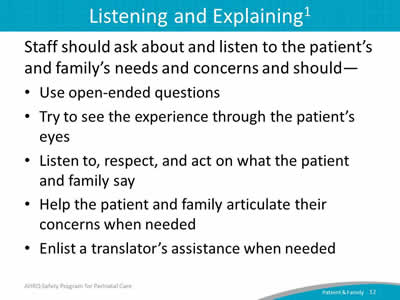
Staff should ask about and listen to the patient's and family's needs and concerns and should—
- Use open-ended questions.
- Try to see the experience through the patient's eyes.
- Listen to, respect, and act on what the patient and family say.
- Help the patient and family articulate their concerns when needed.
- Enlist a translator's assistance when needed.
Slide 13: Role of a Doula3
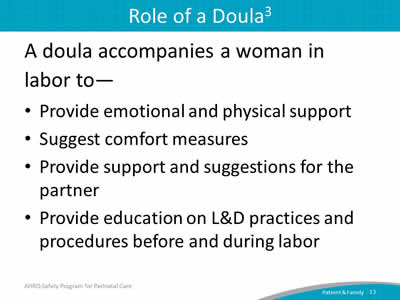
A doula accompanies a woman in labor to—
- Provide emotional and physical support.
- Suggest comfort measures.
- Provide support and suggestions for the partner.
- Provide education on L&D practices and procedures before and during labor.
Slide 14: Role of a Doula3
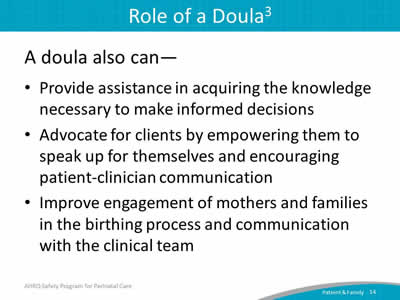
A doula also can—
- Provide assistance in acquiring the knowledge necessary to make informed decisions.
- Advocate for clients by empowering them to speak up for themselves and encouraging patient-clinician communication.
- Improve engagement of mothers and families in the birthing process and communication with the clinical team.
Slide 15: Engaging With the Help of a Doula
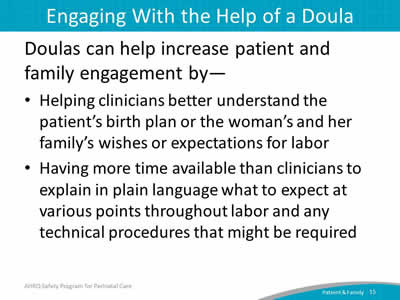
Doulas can help increase patient and family engagement by—
- Helping clinicians better understand the patient's birth plan or the woman's and her family's wishes or expectations for labor.
- Having more time available than clinicians to explain in plain language what to expect at various points throughout labor and any technical procedures that might be required.
Slide 16: Engaging With the Help of a Doula
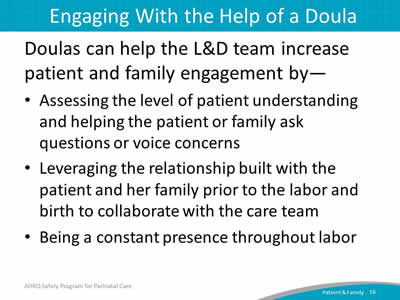
Doulas can help the L&D team increase patient and family engagement by—
- Assessing the level of patient understanding and helping the patient or family ask questions or voice concerns.
- Leveraging the relationship built with the patient and her family prior to the labor and birth to collaborate with the care team.
- Being a constant presence throughout labor.
Slide 17: Engaging After Adverse Events
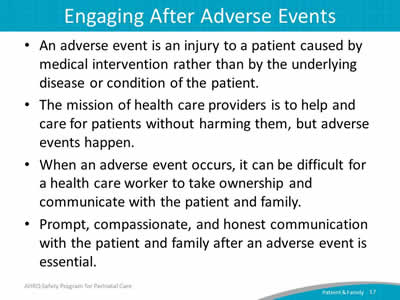
- An adverse event is an injury to a patient caused by medical intervention rather than by the underlying disease or condition of the patient.
- The mission of health care providers is to help and care for patients without harming them, but adverse events happen.
- When an adverse event occurs, it can be difficult for a health care worker to take ownership and communicate with the patient and family.
- Prompt, compassionate, and honest communication with the patient and family after an adverse event is essential.
Slide 18: Immediate Response to an Adverse Event4
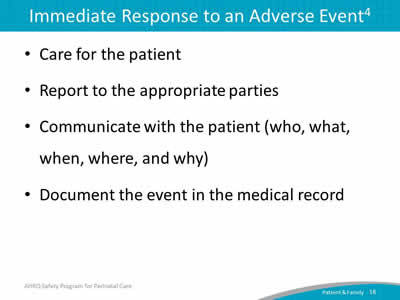
- Care for the patient.
- Report to the appropriate parties.
- Communicate with the patient (who, what, when, where, and why).
- Document the event in the medical record.
Slide 19: Adverse Event Initial Communication4
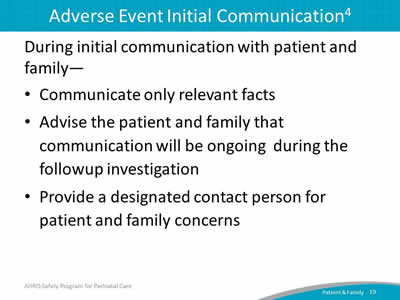
During initial communication with patient and family—
- Communicate only relevant facts.
- Advise the patient and family that communication will be ongoing during the followup investigation.
- Provide a designated contact person for patient and family concerns.
Slide 20: How To Communicate About an Adverse Event5
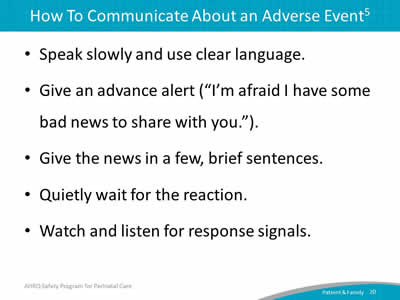
- Speak slowly and use clear language.
- Give an advance alert ("I'm afraid I have some bad news to share with you.").
- Give the news in a few, brief sentences.
- Quietly wait for the reaction.
- Watch and listen for response signals.
Slide 21: Next Steps in Responding to an Adverse Event6
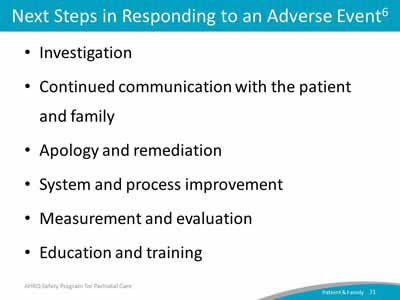
- Investigation.
- Continued communication with the patient and family.
- Apology and remediation.
- System and process improvement.
- Measurement and evaluation.
- Education and training.
Slide 22: The Second Victim: Health Care Workers7
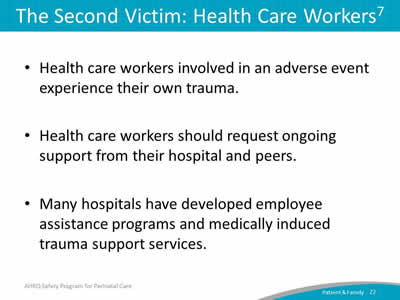
- Health care workers involved in an adverse event experience their own trauma.
- Health care workers should request ongoing support from their hospital and peers.
- Many hospitals have developed employee assistance programs and medically induced trauma support services.
Slide 23: Engaging in Planning and Design: Continuing Patient and Family Involvement1
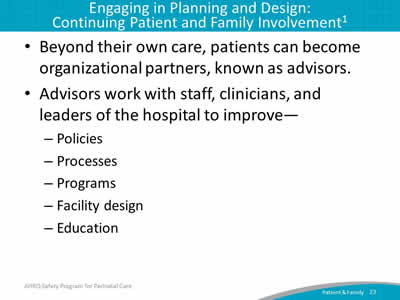
- Beyond their own care, patients can become organizational partners, known as advisors.
- Advisors work with staff, clinicians, and leaders of the hospital to improve—
- Policies.
- Processes.
- Programs.
- Facility design.
- Education.
Slide 24: Who Are Advisors and What Do They Do?
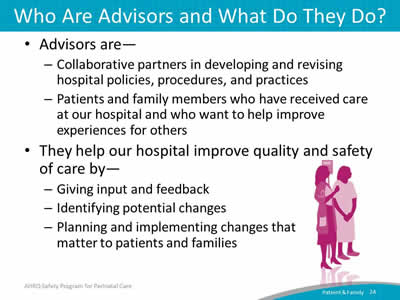
- Advisors are—
- Collaborative partners in developing and revising hospital policies, procedures, and practices.
- Patients and family members who have received care at our hospital and who want to help improve experiences for others.
- They help our hospital improve quality and safety of care by—
- Giving input and feedback.
- Identifying potential changes.
- Planning and implementing changes that matter to patients and families.
Slide 25: Summary
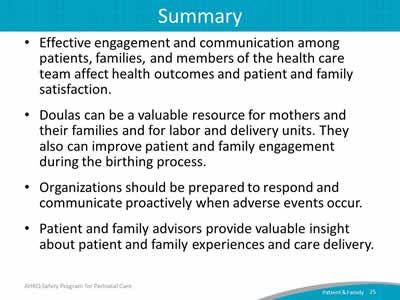
- Effective engagement and communication among patients, families, and members of the health care team affect health outcomes and patient and family satisfaction.
- Doulas can be a valuable resource for mothers and their families and for labor and delivery units. They also can improve patient and family engagement during the birthing process.
- Organizations should be prepared to respond and communicate proactively when adverse events occur.
- Patient and family advisors provide valuable insight about patient and family experiences and care delivery.
Slide 26: Tools
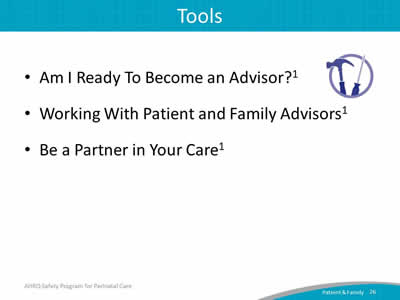
- Am I Ready To Become an Advisor?1
- Working With Patient and Family Advisors.1
- Be a Partner in Your Care.1
Slide 27: References
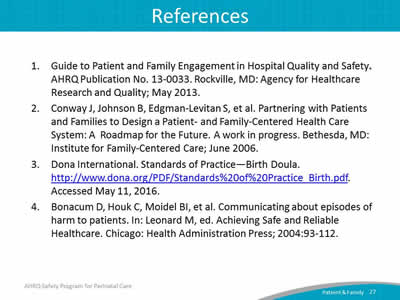
- Guide to Patient and Family Engagement in Hospital Quality and Safety. AHRQ Publication No. 13-0033. Rockville, MD: Agency for Healthcare Research and Quality; May 2013.
- Conway J, Johnson B, Edgman-Levitan S, et al. Partnering with Patients and Families to Design a Patient-and Family-Centered Health Care System: A Roadmap for the Future. A work in progress. Bethesda, MD: Institute for Family-Centered Care; June 2006.
- Dona International. Standards of Practice—Birth Doula. http://www.dona.org/PDF/Standards%20of%20Practice_Birth.pdf. Accessed May 11, 2016.
- Bonacum D, Houk C, Moidel BI, et al. Communicating about episodes of harm to patients. In: Leonard M, ed. Achieving Safe and Reliable Healthcare. Chicago: Health Administration Press; 2004:93-112.
Slide 28: References
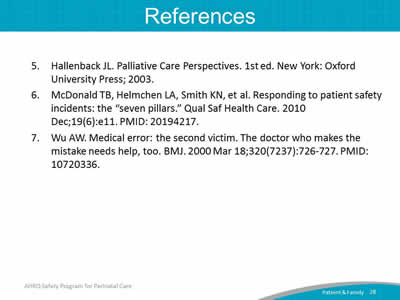
- Hallenback JL. Palliative Care Perspectives. 1st ed. New York: Oxford University Press; 2003.
- McDonald TB, Helmchen LA, Smith KN, et al. Responding to patient safety incidents: the "seven pillars." Qual Saf Health Care 2010 Dec;19(6):e11. PMID: 20194217.
- Wu AW. Medical error: the second victim. The doctor who makes the mistake needs help, too. BMJ 2000 Mar 18;320(7237):726-727. PMID: 10720336.
Slide 29: Disclaimers
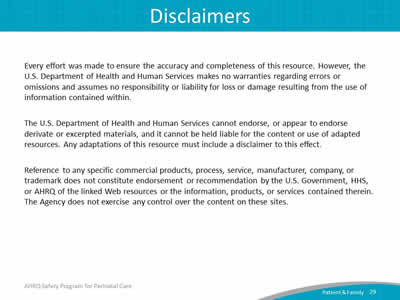
Every effort was made to ensure the accuracy and completeness of this resource. However, the U.S. Department of Health and Human Services makes no warranties regarding errors or omissions and assumes no responsibility or liability for loss or damage resulting from the use of information contained within.
The U.S. Department of Health and Human Services cannot endorse, or appear to endorse derivate or excerpted materials, and it cannot be held liable for the content or use of adapted resources. Any adaptations of this resource must include a disclaimer to this effect.
Reference to any specific commercial products, process, service, manufacturer, company, or trademark does not constitute endorsement or recommendation by the U.S. Government, HHS, or AHRQ of the linked Web resources or the information, products, or services contained therein. The Agency does not exercise any control over the content on these sites.



